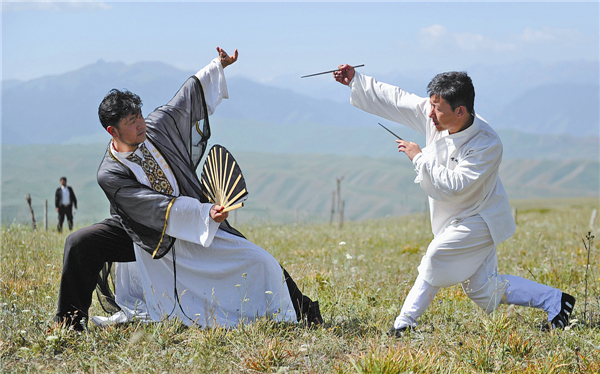 |
|
Representatives from different schools of Wushu, a traditional Chinese martial art, demonstrate their skills on the grasslands near Tianshan Mountain for a kung fu show this week. They were criticized online for putting on a show rather than popularizing martial arts. Ma Yuan / for China Daily
|
Wushu, a traditional Chinese martial art, has made a major development in global self-promotion with the development of a standardized evaluation system over the past two years.
Created by the Chinese Wushu Association in 2011, the Chinese Wushu Duanwei System, a hierarchical system that evaluates practitioners' qualifications, combat skills, theoretical knowledge and martial morality, has effectively provided unified access and understandable education to learners, according to a development report released by the association on Tuesday.
According to the report, 257,137 domestic exercisers and 3,409 overseas practitioners from 69 countries and regions have obtained classifications in the system, which grades players from low to high as follows: Primary Duan (first through third), Middle Duan (fourth through sixth) and Advanced Duan (seventh through ninth).
There is also pre-Duan grading, which has three levels. Each Duan class requires a certain number of years of practice, a level of theoretical and practical ability, martial arts ethics and etiquette.
Wushu, which has long intrigued foreigners with its miraculous moves in kung fu movies and novels, has developed into hundreds of styles and schools, some of which grew in popularly while others gradually vanished.
The charm of wushu's extensive and profound roots has attracted worldwide attention while presenting challenges to promoting the martial-art form internationally. As a result, the introduction of unified standards was important, a top official said.
"The formulating of the Duanwei System helped wushu lift its veil to the world by offering clear classifications, straightforward training methods, and unified management of all schools," said Xiao Tian, China's deputy sports minister, who is in charge of wushu development.
The system covers 23 of the most popular styles, including changquan, shaolinquan and taijiquan (tai chi) out of the 129 schools identified by the CWA, which compiled textbooks, offered assessment methods and organized exams at 629 test centers around the country.
We recommend:
